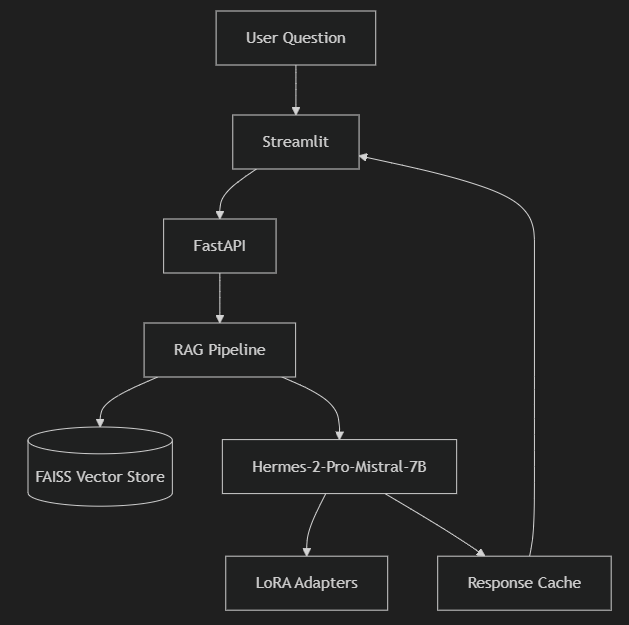🚀 AskMyDocsAI: Your Intelligent Document Assistant 📚🤖
💯 Motivation
After mastering core concepts in NLP and Large Language Models (LLMs), I decided to apply these skills to create AskMyDocsAI, a comprehensive AI assistant. My goal was to build a practical, interactive tool that allows users to effortlessly extract accurate, document-grounded answers from their own uploaded documents.
This project integrates several advanced AI techniques and frameworks, including:
Retrieval-Augmented Generation (RAG) for improved accuracy.
LangChain for enhanced reasoning and agent-based interactions.
LoRA fine-tuning (QLoRA) for efficiently training large models on consumer hardware (RTX 3060 GPU).
It has also provided an excellent opportunity to dive deeply into real-world challenges like cloud deployment, scalable architecture, and user-friendly interfaces.
🧠 Key Features
📤 Document Upload & Processing: Supports PDFs, DOCX, TXT, and CSV, parsed and indexed using a FAISS vector store.
🔍 Retrieval-Augmented QA: Delivers answers grounded in document content, significantly reducing hallucinations.
🎛️ LoRA Fine-Tuning (QLoRA): Enables efficient fine-tuning of large language models (7B+) using consumer GPUs (like RTX 3060).
🛠️ LangChain Agent Integration: Handles complex, multi-step queries using ReAct paradigm.
⚡ FastAPI & Streamlit Frontend: User-friendly web interface connected via RESTful API for smooth interactions.
🔍 Model Selection and Implementation
Initially, the system was configured with meta-llama/Llama-3.1-8B. However, for improved instruction-following capability and superior retrieval performance, I transitioned to using NousResearch/Hermes-2-Pro-Mistral-7B. This model excels in coherence and is optimized specifically for retrieval tasks, making it ideal for document-based question answering.
🏗️ System Architecture
Here’s how the system processes your questions:

🛠️ Technical Challenges & Solutions
GPU Constraints: Given my RTX 3060 GPU (6GB VRAM), I adopted QLoRA fine-tuning to optimize resource usage.
Optimizing RAG Pipeline: Extensive experimentation determined optimal chunking, MMR diversity, FAISS indexing, and Cross-Encoder reranking strategies to maximize retrieval quality.
Frontend Integration with Streamlit: Leveraged Streamlit’s Python integration capabilities, simplifying UI development by directly interacting with the backend FastAPI services.
RAG Pipeline Development: A significant portion of development time was spent refining the rag_pipeline.py for optimal document retrieval, query processing, and answer generation, including robust caching strategies.
Fine-Tuning Efficiency: Prepared data carefully to maintain quality and relevance, using efficient formats (JSONL, Parquet, Arrow) for fine-tuning datasets.
📊 Training Procedure
Dataset: Alpaca-cleaned (10,000 samples)
Method: LoRA (Low-Rank Adaptation)
Epochs: 3
Batch Size: 4 (with gradient accumulation)
Learning Rate: 1e-4
Optimizer: AdamW with cosine decay and warm-up
Hardware: RunPod Cloud (NVIDIA RTX A5000 GPU)
Training logs monitored via TensorBoard and WandB for thorough performance tracking.
📈 Evaluation Metrics
Validation Loss: Consistent decrease, indicating stable and effective training.
Instruction-Following Accuracy: Enhanced coherence and context-awareness after fine-tuning.
🌐 Future Direction
Enhanced Training: Train the entire dataset with larger models for greater accuracy.
Cloud Deployment: Scale AskMyDocsAI deployment on AWS, GCP, or Azure.
Multi-Document Support: Enable simultaneous multi-document uploads for comparative analyses.
Conversational Interface: Develop sustained, multi-turn dialogue interactions similar to ChatGPT.
💡 Why RAG and LoRA?
RAG: Keeps LLM answers factually accurate by dynamically retrieving relevant, up-to-date information directly from documents at query-time.
LoRA: Allows lightweight, efficient customization of the model’s instruction-following capability, making domain-specific adaptations quick and resource-friendly.
⚙️ Quick Start Guide
To quickly deploy AskMyDocsAI locally:
git clone https://github.com/kwanlung/ask-my-docs-ai.git
cd AskMyDocsAI
pip install -r requirements.txt
uvicorn src.app:app --host localhost --port 8000
streamlit run streamlit_app.py
🤝 Contribution
Feel free to contribute via GitHub issues or pull requests!
📜 License
MIT License
📬 Connect with Me
Dean Ng Kwan Lung
Blog : Portfolio
LinkedIn : LinkedIn
GitHub : GitHub
Email : kwanlung123@gmail.com